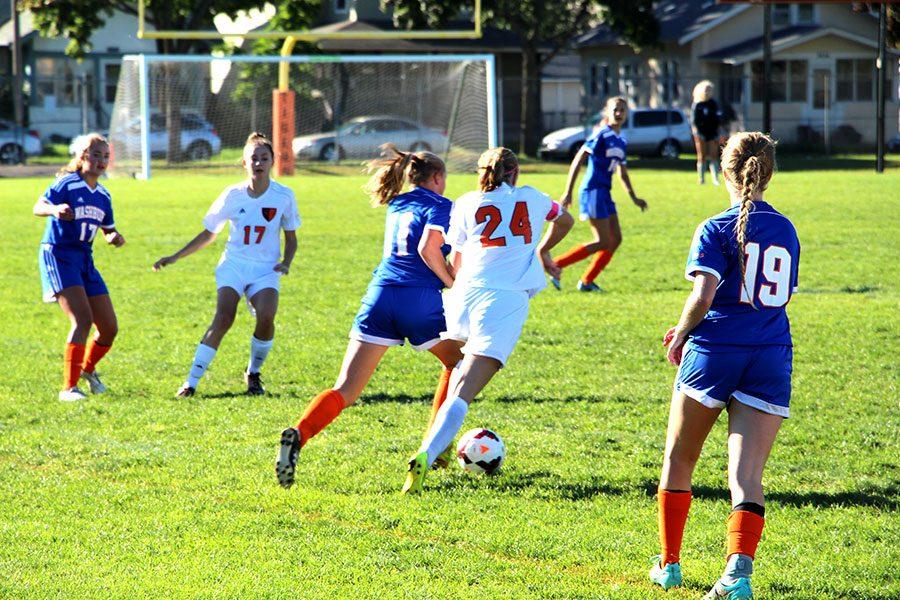With different bodies, come different injuries
Maisy Johnson (freshaman) and Grace Larson (senior) playing in a game against Washburn.
October 11, 2016
Female bodied athletes are more prone to getting injured in sports, it’s simply anatomy. The way their hips are placed and the greater extent of flexibilities that comes along with getting less body muscle then male bodied people during puberty. Does this affect female bodied people joining sports?
According to Science Daily many female bodied training programs are built on research using male bodied people. These training programs don’t take the differences of anatomy into account.
Female bodied people and male bodied people run differently, female bodied people are more likely to be knock kneed (a suspected factor of getting more injuries), because of their wider hips. The flexibility female bodied people sustain is also a risk, with less muscle there isn’t enough strength to keep the joints in a safe stable position. You can easily imagine the injuries possible.
Tosin Odumuye, a senior on the girl’s varsity soccer team who recently suffered an ACL tear explains the experience; “I stepped, and heard a pop, it felt like I kind of like twisted it but also snapped it in the wrong direction. It was like a fast thing, and then I was just on the ground and it was just throbbing and it was numb.”
Odumuye also explained the difficulty of recovery, “The hardest part is doing all of my exercises and physical therapy everyday,” she said. “And I’m missing a lot of school, so it’s hard to keep up with my classes.”
According to Outside the Lines, a blog about “what sports administrators, coaches and parents need to know” there are between 100,000 and 200,000 ACL ruptures per year in the United States. More likely from athletes running, jumping or suddenly slowing down and changing direction; less from athletes running into each other. ACL injuries happen 4-6 more times to female bodied people than to male bodied people.
Someone who is aware of this issue is Jillian Stockimo, the south girls varsity team’s coach. She tore her MCL (medial collateral ligament), which keeps your knee from bending inward, while playing soccer in college and had more injuries that ultimately ended her career.
“It’s one of those things that you never think it’s going to happen to you,” Stockmo explained. “I made it all through highschool without an injury and did it in college it was just like a career ender for me.”
Stockmo explained that every year a couple of the girls get injured. It can range from concussions, to rolled ankles, to torn ACL’s. “We’ve had a lot of injuries in the years that I’ve coached here,” Stockmo said.
The girls varsity team is very young this year, and Stockmo explained how female bodied people are more susceptible to injury when they’re still developing and growing.
Emile Benick, the trainer for south high soccer, talked about how the research shows that female bodied people have different shaped pelvises, which gives them something called a Q angle. The Q angle is the angle from your hip to your knee to your ankle and female bodied people have a greater angle. If the angle is greater it has a greater distance to go, so if you have one misstep it’s going to move farther.
Benick also explained the recent research about the connection between female bodied people’s menstruation cycles and injuries. About a week before female bodied people mestruate their hormones change, and that makes their ligaments or ACL’s looser. If the ligaments are looser that makes them more prone to injury.
Benick said that female bodied people are much more likely to get torn ACL’s in middle school, when they’re going through puberty, while male bodied people are more likely to get torn ACL’s in their freshman year of college. “It really depends on the sport and level you are at,” Benick explained.
But there are ways to avoid tearing your ACL; according to the University of Colorado Hospital neuromuscular training is perfect. Neuromuscular training increases the strength of your knee joint and increases your awareness of proper balance and technique.
If you do tear your ACL, your recovery has everything to do with your compliance with your rehab, a full recovery takes about 6-9 mounths.In any recovery from an injury you work on “increasing function and decreasing pain” explained Benick. Function activities or sports activities are used to slowly recover.
Function activities are exercises that help to strengthen your muscles and improve balance and proprioception, which is the human body’s ability to react and prevent an injury. Your exercises depend on what sport you’re returning to, if you’re returning to soccer you would do the drills you do in practice to slowly get yourself back to playing on the field.
“I think something that we sometimes forget is that sometimes with female injuries they end up being career ender, season ender.” Stockmo said. “They’re much more drastic than what I see in the male injuries.”
.







Celia Novaes • Oct 20, 2016 at 8:44 am
Thanks for bringing that subject to light! Well done Luca Raffo- Simoes! ??????